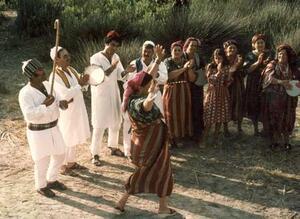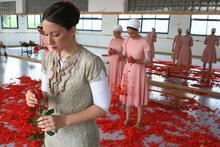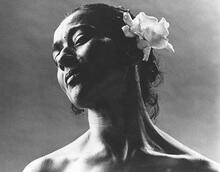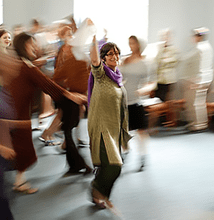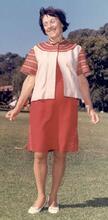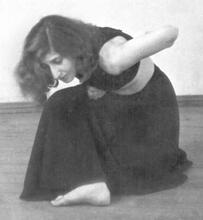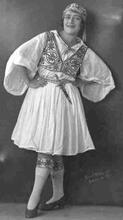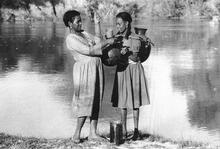Community Dance Practices in the Yishuv and Israel: 1900-2000
Women have been at the forefront of preserving community dance practices in Israel. In the 1970s Gurit Kadman worked with ethnomusicologist Dr. Esther Gerson-Kiwi to collect, document, and study ethnic music and dance practices in Israel. Eventually elements of ethnic dances were incorporated into the canon of Israeli folk dance. Several women in addition to Kadman highlighted the importance of preserving these community dance practices. Rachel Nadav was a Yemenite Jew who established a dance company of her own after dancing in Rina Nikova’s Yemenite ballet troupe. Sara Levi-Tanai, the daughter of Yemenite Jews, established the Inbal Dance Theater in 1949. The immigration of Ethiopians to Israel beginning in the 1980s led to the formation of an Ethiopian dance company called the Eskesta Dance Theater.
In order to examine the subject of women and ethnic dances in Israel (as well as pre-State Palestine), one must define the various categories that come under this heading and explain what distinguishes and what unites them. The unique modes of ethnic dance in Israel are more properly referred to as dances of various ethnic communities, encompassing both Jewish and non-Jewish ethnic groups. This article, devoted to the role of women in ethnic dances, may be divided into two primary topics: the first concerns the role, state and function of women in the dances of the various ethnic communities, and the second, individual women who contributed to the cultivation and development of ethnic dances through their work in creating, studying and organizing this field.
An important topic that is closely connected with the dances of the ethnic communities is that of Israeli folk dance. The differences and similarities between them highlight the unique features of society and culture in the State of Israel.
Defining Terms
Ethnic dance is part of the broader category of ethnic culture. The word “ethnic” refers to various groupings of individuals, for example in the form of a nation, race, or community. In pre-modern times, ethnic groups were defined as a unit that shared a common history, distinct geographical boundaries, and a shared culture including a common language, religion, rites, rituals and festivals. Such aspects of folklore as music, dance, dress, jewelry, material culture, food, and so forth are among the features that characterize the members of the group. These patterns were formed and shaped in a lengthy process of largely collective creativity dating back to the distant or more recent past. This legacy is passed from generation to generation through imitation, experience and informal learning, with the group members participating in events that form part of the lifestyle and experience of the collective. Over an extended period of time, changes take place in the living conditions of the group members that in turn lead to modifications in the elements that make up the heritage.
As a result of industrialization, urbanization and sophisticated technology and communications, as well as conquests and migrations, new contacts are forged and old boundaries are breached, causing a blurring of the unique features of each cultural group. Reciprocal influences between various cultures, near and far, lead to varying degrees and durations of change and transformation. These changes are based on the creative ability of the members of the group to adapt to a shifting environment, and to varying conditions and patterns, coupled with their ability to incorporate these phenomena into their culture—an indication of their success at coping with new situations. The members of the group possess a common language and a shared music, encompassing instruments, songs and dances. The dance performed on a particular occasion does not stand alone but is one of many elements such as music, dress and ornaments, food, pageants and so on that together constitute the totality of the event.
A common process in such situations is known as acculturation, defined as a marginal or specific culture’s adaptation to the dominant culture. This process is typical of regions with heterogeneous populations. These are generally lands peopled by groups of immigrants that have come from various countries at various times, bringing with them traditions and a heritage from their countries of origin. In the host country and society, it is expected that the immigrants will adapt and take on the patterns of the dominant culture. Conflict within and between different ethnic groups, generated by competition over resources and social status, creates feelings of discrimination among the immigrants, who make up the weaker elements of society. In seeking to strengthen their standing in society, they display a tendency to abandon the ethnic patterns and lifestyle they brought with them in favor of patterns that are perceived as universal and are accepted by the host society.
Ethnicity & Culture in Israel
Israel is a classic example of a land of immigration, with all of the characteristics described above. Since immigration to Israel is seen by Zionist ideology as “going up” (hence the Hebrew term Lit. "ascent." A "calling up" to the Torah during its reading in the synagogue.aliyah), the newcomers are considered female/sing.; individual(s) who immigrates to Israel, i.e., "makes aliyah."olim (“those who ascend”). This same perception places the indigenous Israeli cultural creation at the center of the cultural endeavor. Alongside the concept of “negation of the Lit. (Greek) "dispersion." The Jewish community, and its areas of residence, outside Erez Israel.Diaspora,” which, despite the Holocaust, still influenced the Israeli public, there emerged an unequal—and even negative—attitude toward cultures imported by the Jews from their native lands in the Diaspora.
The orientation of “dominant” Israeli society is largely Western and modern; by contrast, the olim from the Islamic countries of the Middle East and North Africa are considered less advanced. The state is therefore required to create the tools and the channels for accelerating the process of turning the new immigrants into “Israelis.” In Israel, as in other lands of immigration, this process is described as a “melting pot”; in keeping with accepted Israeli perceptions, however, it is also referred to as the “ingathering of the exiles.” The question that arises from these processes is whether cultural pluralism indeed exists in Israel or whether there is an Israeli “dominant culture,” with ethnic sub-cultures positioned in a hierarchy of sorts, in terms of how they are viewed by the Establishment. There is no unequivocal answer to this question, for both situations coexist simultaneously—the creation of an overarching Israeli culture alongside the attempt to preserve particularist traditions. Today, the trend throughout the world, including Israel, is toward multiculturalism.
Israeli Folk Dance and New Immigrants
Pre-State Israeli folk dances began to be created in the 1930s and 1940s. It was seen as a necessity of the period, and conformed to a Zionist ideology that sought to “invent” Israeli arts and culture as a common basis and form of expression of the Jewish population in Israel. The process of creating music and folk dances originated primarily in the labor settlements as part of the shaping of patterns of nature festivals and agricultural celebrations. Frameworks were created for the various seasonal festivals, which the artists filled with new content and meanings. The Bible was the foundation and source of reference, not its religious aspect but in the historical and national sense, so that the biblical narratives and their heroes served as a source of inspiration for composers and choreographers.
With the establishment of the state and the mass aliyah of Jewish communities from the four corners of the earth, the longstanding members of the Jewish community in Palestine prior to the establishment of the State of Israel. "Old Yishuv" refers to the Jewish community prior to 1882; "New Yishuv" to that following 1882.Yishuv (pre-State Jewish community) became aware, virtually for the first time, of the heritage of the various ethnic groups, in particular that of the Middle Eastern communities, which had preserved their authentic folklore before it underwent a process of modernization with its accompanying Western overtones. In these early stages, it was necessary to encourage the members of these communities to maintain their customs and lifestyle while adapting to new life-patterns. As part of this adjustment, they were obliged to learn and adopt Israeli folk dances and folk songs at the same time as they were learning the Hebrew language.
Over time, the new immigrants and the “veteran” population drew closer to one another. Many of the creators of Israeli folk dance looked to the dances of the various ethnic communities, from which they drew elements that they incorporated into the new dances. The communities that constituted the major source of inspiration in the formulation of Israeli folk dance were the Yemenites, the hasidim and the Arabs.
It was Gurit Kadman who conceived the idea of preserving, reviving and maintaining these ethnic traditions; immediately upon the new immigrants’ arrival, she went out with her cameras, assisted by the ethnomusicologist Dr. Esther Gerson-Kiwi, to the transit camps where the immigrants were concentrated to record their dances on film along with their music and traditional dress. But Kadman did not limit herself to preservation; she and her fellow volunteers encouraged the members of ethnic communities to preserve their longstanding traditions, to retain their customs, play their instruments, sing their songs and dance their dances in their original costumes.
The most important festivity in most of the communities, in which all of these arts converged, was the wedding with its many parts and rituals, the most outstanding of which was the hinnah (henna) ceremony that precedes the marriage ritual. The hinnah itself is a paste made from the henna plant, which is credited with mystical qualities and various effects on the married couple, in particular on the fertility of the bride. The paste is spread on the palms of the bride in a ceremony compromised of pageants, song, musical instruments, numerous dances and large quantities of food. The paste turns a reddish color upon contact with the skin, serving as an adornment for the bride on her day of celebration. For those who believe that the rite of passage of the wedding represents a dangerous interim stage in the lives of the couple, the color changes the appearance of the bride so that she is not recognized by the hostile forces seen as attempting to conspire against the couple. The red color also has symbolic significance in that it recalls the color of blood, which relates to menstruation and the blood of the bride’s hymen as well as the blood of childbirth. This ceremony carried great meaning for communities in the past, but its importance has decreased since their arrival in Israel; though it is still practiced, it is no longer widespread. In certain communities, the ceremony is conducted separately for the bride and the groom.
The present discussion of the heritages of Israel’s communities also extends to its many Arab populations: Muslims, Christians, Druze, Bedouins and Circassians (who are not Arab but are Muslim). Thus, any exploration of the subject of ethnic dances in Israel refers to them as well.
Project for the Preservation and Fostering of Ethnic Dance
In 1971, as part of the Center for Culture and Education of the Histadrut Labor Federation, Gurit Kadman founded the Project for the Preservation and Fostering of Ethnic Dance, which set as its goal the preservation and nurturing of the ethnic communities’ heritage, in particular the festivals and ceremonies in which dance played an important role. The Project encouraged the formation of performing ensembles of the various ethnic groups, supported them financially, offered them professional guidance, and brought in expert dancers and musicians from the ethnic communities themselves. In order to draw Israelis closer to these traditions, the Project organized courses for teachers of folk dance in which they were exposed to the cultures of the ethnic communities and learned their dances. One of the objectives was to train them as researchers so that they would be able to record the dances, hold interviews with field informants and conduct participant observations centered around the ethnic holidays and rituals. Eventually, ethnic dances began to be included at regional, national and international gatherings and festivals in Israel and abroad.
From the late 1970s, when Kadman stepped down as director of the Project, it was run by several other women, including Ruth Ashkenazi, who worked alongside Kadman and directed the Project from 1973 to 1983; and Rina Sharett, who ran it from 1987 to 1990.
From 1944 to 1968 national dance festivals were held at A voluntary collective community, mainly agricultural, in which there is no private wealth and which is responsible for all the needs of its members and their families.KibbutzDaliyyah; among the participants were ethnic dance troupes, whose representation increased from the third festival (1951) onward. Prior to the 1951 festival, several waves of aliyah brought massive numbers of new immigrants from Asia and Africa whose cultural heritage aroused great interest and attention among those institutions and individuals involved with culture in general and in particular with dance and music, which constitute an important part of the heritage of several ethnic communities. (It should be noted that there are differences in the degree of importance attached to dance in the culture and lifestyle of the various communities.)
From the 1960s onward, with the encouragement of the Project for the Preservation and Fostering of Ethnic Dance, and in conjunction with the Ministry of Education and Culture and the Ministry of Tourism, a number of festivals devoted solely to ethnic dances were organized, at which ethnic troupes appeared before the general public in various cities and regional locales. Stage director Shulamit Bat-Dori (1904–1985), a member of Kibbutz Mishmar ha-Emek, staged two of these major festivals, which took place in the three major cities (Tel Aviv, Jerusalem and Haifa) in 1961 and 1963, under the title “From the Ends of the Earth.”
Bat-Dori also directed the final two dance festivals at Kibbutz Daliyyah (in 1958, as part of Israel’s tenth-anniversary celebrations, and in 1968, marking the state’s twentieth anniversary), in which many ethnic troupes participated and made an impact with their uniqueness. The ethnic dance troupes represented at the festivals included Jews hailing from various parts of Yemen—Haban in the southeast, Haidan in the north, and different regions of central Yemen; from Kurdistan; and from India and Cochin. The Bukharan Jews performed their songs accompanied by the unique instruments of the Bukhara and Azerbaijan regions. The so-called “hasidic dances” of the Jews of Eastern Europe were performed by folk ensembles since it was unthinkable that hasidim would dance in public, particularly in front of a mixed audience. The program also included Arab dance troupes, with Muslim, Druze and Christian members. It is noteworthy that an Arab dance troupe from East Jerusalem, composed entirely of Christian Arabs, appeared for the first time at the festival in 1968; the men and women danced together—a phenomenon previously unknown among Israeli Arabs. The artistic director and choreographer of the troupe was Ayalah Goren-Kadman.
Alongside the trend toward fostering the dance practices of Israel’s communities, it was argued in certain quarters that there was no need or justification for preserving the heritage of certain groups since there were doubts as to the extent of their “Jewishness”; in such cases, cultural influences of the non-Jewish populations in their countries of origin had made their way into the lifestyle and holidays of these Jews and left their imprint on the dances and music as well.
Gender & Dance
Separation between the sexes in various spheres of life is practiced in many traditional societies, in particular when life is conducted according to religious rules and customs. In Israel, this separation is particularly strict among certain Jewish and Arab ethnic communities and is strongly manifest in the area of dance; the phenomenon is especially prevalent in the Yemenite community, in ultra-Orthodox society with its assorted hasidic courts, and in Arab society, in particular among Muslims. In certain extreme cases men and women are prohibited from mingling at family gatherings, including the various ceremonies related to marriage. In any event, physical contact between the sexes while dancing is forbidden.
In the hasidic literature concerning the conduct of men and women at marriage ceremonies, one encounters the term “kerchief (or tikhel) dance” in which the bride grasps one end of a kerchief held by the groom or by the bride’s father, in keeping with the prohibition against physical contact even between relatives without an intervening object such as a piece of cloth or a gartel (a type of sash worn by hasidic men; in this case, the bride holds the end of the belt wrapped around the male’s waist).
Absolute separation exists in the Orthodox synagogue setting, where a separate section is dedicated to the women in which they are supposed to see but not be seen, as the exposure of women before a group of men is considered immoral and is associated with strict prohibitions in certain religious circles.
This attitude has ramifications with respect to the rules of conduct for women when dancing in haredi (ultra-Orthodox) society, where they are expected to conceal their figures and make small, unobtrusive movements so as not to call attention to their bodies. In other ethnic communities, some sort of separation is likely between the sexes during dancing, but it is not as strictly observed; consequently, men and women can be found in the same area and even dancing side by side. Such a situation is particularly noticeable among Kurdish Jews, where men and women dance together in close physical proximity, holding hands in assorted clasps and using identical movements and step patterns. The question arises as to whether these patterns were also common in the countries of origin or were formed and reinforced through changes that took place in their lifestyle in Israel. The members of these ethnic groups attest that at major celebrations, especially within the family framework, young men and women danced together, generally after the older generation had taken their leave.
Among natives of the Maghreb region of North Africa—Morocco, Algeria, Tunisia, Libya and Djerba—as well as Iraq, Egypt, Syria and other Middle Eastern countries, there are a variety of situations in which different degrees of separation or proximity between the sexes during dancing are practiced.
In traditional dance patterns, the degree of similarity or dissimilarity between the dances of men and of women differs from group to group. There are obvious differences between the sexes in the dances of the Yemenites, the hasidim, the Georgians and Caucasians, the Bukharans, the Indians and the Arabs, while there is great similarity in the dances of the Kurds and Ethiopians.
Jewish communities that resided in lands where Islam was the dominant culture were marked by separation between the sexes, differences in dance style, and inferior status on the part of women. Life in Palestine (and later, Israel), its Western orientation, and the adoption of a modern way of life, all created changes in the relationship between men and women in general that found expression in dance as well. In the haredi and hasidic societies originating in Eastern Europe, strict separation between the sexes was maintained also in Israel.
Holidays of Various Jewish Communities
A number of holidays occupied an important place in the lives of various ethnic groups in their countries of origin, and continued to do so in Israel as well. Those which have had a resounding impact in Israel are first and foremost the Mimouna festival, which was held in the Maghreb countries of North Africa, primarily Morocco; and the Seharane, celebrated by the Jews of Kurdistan.
The Mimouna was celebrated abroad and continues to be marked on Isru Hag of A seven-day festival to commemorate the Exodus from Egypt (eight days outside Israel) beginning on the 15th day of the Hebrew month of Nissan. Also called the "Festival of Mazzot"; the "Festival of Spring"; Pesah.Passover (the day after the conclusion of the weeklong holiday). This day symbolizes the transition from the special regulations of the holiday back to ordinary weekdays, and from eating only food that is Term used for ritually untainted food according to the laws of Kashrut (Jewish dietary laws).kosherfor Passover to consuming regular food. Far-reaching changes have taken place in the meanings, functions and atmosphere of this celebration since its “arrival” in Israel. While the Mimouna originally had a more familial and community-oriented character, in Israel it is held in large public parks and is more public and exhibitionist in nature. One of the major aspects of the festivities, which take place on the evening immediately following the close of Passover, is the “open house,” at which all are given a warm welcome. This unique hospitality is expressed above all in the numerous types of delicacies and cooked foods that are served, especially sweets, dairy foods and fish. The various dishes symbolize fertility (fish), the fruits of the earth, and wishes for a sweet life. From this description, one can easily conclude that the major burden of the holiday preparations, cleaning and decorating the home and cooking the many dishes, falls upon the woman. It was customary on this day to conduct various transactions, prominent among which were shiddukh agreements (arranged marriages). It is important to note that this holiday was not religious in nature; its primary significance was and is cultural/social, although its roots lie in the universal traditions and rituals relating to the seasons of the year and festivals of nature, and the Mimouna can be viewed as a celebration of spring.
The Seharane festival should be understood in the context of the overall lifestyle (both general and Jewish) in Kurdistan, a hilly region in which winter is lengthy, the mountains are covered in snow, and people are homebound during the winter months. With the coming of spring at the end of this difficult season, people would go out to celebrate in the bosom of nature, with much singing, especially ballads of daring and romance; playing of the zurna (a mountain flute of the woodwind family) and the dahola (a giant drum); dancing (especially group circle-dances); and even storytelling. In addition, it was customary to visit the graves of righteous elders, who were a focal point of this way of life, providing a meeting place between Jews and Muslims. There was much in common between Jew and non-Jew in the nature and style of these holidays, as reflected in the similar patterns of music, dance, dress and foods. Although the Jews had a language of their own—a special Aramaic dialect—their secular songs (dance songs and ballads) were sung in the language of the general community, Kurmanji.
As stated, both of these ethnic holidays continue to be central to the group members’ identification with their ethnic heritage, despite the far-reaching changes they have undergone in Israel. One of the most obvious changes has involved the timing of the Seharane festivities in Israel (solely during the Intermediate Days of Lit. "booths." A seven-day festival (eight days outside Israel) beginning on the 15th day of the Hebrew month of Tishrei to commemorate the sukkot in which the Israelites dwelt during their 40-year sojourn in the desert after the Exodus from Egypt; Tabernacles; "Festival of the Harvest."Sukkot, whereas in Kurdistan these festivities took place on the day after Passover [Isru Hag] and at other times during the year). The reason for the change was to avoid clashing with the Mimouna celebration.
Other ethnic groups continue to hold their traditional festivals in Israel, among them the mass festivities on Mt. Meron on Lag ba-Omer, marking the anniversary of Rabbi Shimon bar Yohai, at which members of the various ethnic groups gather. The dominant form of dancing at this site is hasidic dances performed with great fervor by men only. The Sigd is a festival of the Ethiopian community marking the giving of the Torah she-bi-khetav: Lit. "the written Torah." The Bible; the Pentateuch; Tanakh (the Pentateuch, Prophets and Hagiographia)Torah (referred to as the Orit) at Mt. Sinai. It is celebrated on any mountaintop in Jerusalem overlooking the Temple Mount (symbolizing the revelation at Sinai). Likewise, the Jews of the Georgian Republic continue to celebrate their traditional Rozhabek holiday.
While the Yemenite Jewish community did not have a traditional ethnic festival in Yemen apart from the religious holidays, a new tradition of sorts emerged in Israel known as the Teimaniyada—a massive gathering featuring Yemenite songs, dances, costumes, and other aspects of folklore that has won great popularity in Israel. In the absence of a tradition, the timing of the festival is set arbitrarily.
Influential Women
Ethnic dances have made great strides in Israel thanks in large part to several women who highlighted the importance of the legacy of ethnic dances. Some of them were, and continue to be, active in the field of folk dance and others in artistic dance, drawing inspiration and material for their creations from ethnic sources. They are presented below in approximate chronological order.
Rina Nikova, a dancer, teacher and choreographer of classical ballet, immigrated to pre-State Palestine from Russia in 1924. In 1933, she founded a Yemenite ballet troupe, which included several female dancers of Yemenite extraction. Profoundly influenced by their unique style of movement, she attempted to integrate something of this Yemenite style into her dances. Nikova was also affected by the Arab dances that she observed in Jerusalem and incorporated elements of this dance style into her work.
The Rina Nikova troupe went on several European tours and made a strong impression on audiences there. On one of its tours, the company traveled to South Africa, where it had an extremely unpleasant experience in the form of the attitude of the white public towards the Yemenite dancers; due to their dark skin color, they were treated like the local blacks and subjected to the same segregationist restrictions.
Rachel Nadav, born in 1912 in Aden, Yemen, was one of the first dancers to be accepted into the Nikova troupe and quickly became its lead dancer. Nadav later established a company of her own, in which she developed the Yemenite style of movement. She created dances based on authentic Yemenite dance, which she taught to folk dance groups.
Gurit Kadman immigrated to pre-State Palestine from Germany in 1920. While still in Germany, she became interested in folklore and would travel among the villages, which offered a broad canvas for fulfilling her great love of folk songs and dances as well as folk handicrafts; she collected items from all of these arts, which she made use of in her work. After immigrating to Palestine, she tried to learn the local folklore and draw closer to it. As part of her activities throughout the country, especially from the early 1940s onward, she became familiar with the debka dances, and others common in Arab society. The interest in the lifestyle of the Arab farmers on the part of Western Jews from Europe was influenced by the Orientalist school and the romantic attitude in European countries at the time towards the culture of the Levant. Kadman was simultaneously also exposed to Yemenite dances, which fired her imagination. Like numerous other artists from the fields of music, dance and painting, and crafts such as metalworking, embroidery and the like, she saw in Yemenite art an ancient, untainted Jewish culture that had survived from the days of the forefathers. Kadman devoted herself to fostering the dances of all the ethnic communities. She collaborated with academic bodies and others in organizing the documentation and research of ethnic materials, particularly in the fields of music and dance, in addition to folk handicrafts, costumes and jewelry.
Kadman worked in close cooperation with the ethnomusicologist Dr. Esther Gerson-Kiwi, who led the collection, documentation and study of ethnic music in Israel. Together, they recorded on film and audiotape the dances as well as the vocal and instrumental music that the various ethnic groups had brought with them from their countries of origin, along with the music and dance of the indigenous Arab population.
In the elements of ethnic dance, Kadman saw a treasure trove of sources from which to draw a style of movement, dance steps and group formations, and apply them to the process of creating new folk dances. In the chapter entitled “The Future of Ethnic Dance” in her book Ethnic Dance in Israel, Kadman writes: “To summarize, ethnic dances will continue to exist, each ethnic group with its own style and character. Integration on the basis of the misconceived notion of the ‘intermingling of the exiles’ will not take place. A blending in which each unit loses what is unique to it is neither desirable nor certain. Every ethnic group must continue, as much as possible, on its own path with loyalty and with pride. In this way, we will reach a state of pluralism—the existence of independent units with equal rights. It is of course possible that in the process of creating new folk dances, elements of ethnic dance will be integrated and thereby preserved” (61).
At the Seharane festival of Kurdish Jews, held at the Kurdish Cooperative smallholder's village in Erez Israel combining some of the features of both cooperative and private farming.moshavof Zakariyyah in 1971, Kadman was granted the honorary title of “distinguished member of the Kurdish community” for her major contribution to fostering Kurdish heritage, in particular in the field of dance.
Rivka Sturman immigrated to pre-State Palestine from Germany in 1928, settling on Kibbutz Ein Harod in the Jezreel Valley. In her pursuit of stylistic elements that would characterize Israeli folk dance, she created dances that combined movement motifs, steps and group formations found primarily in the dances of Yemenites, Arabs and hasidim. Many of her dances feature different variations of the “Yemenite step,” which forms the basis of two of her best-known works: the couple dances “Dodi Li” and “Iti Mi-Levanon.” The accompanying lyrics are taken from the biblical Song of Songs, while the melody was composed by Nira Chen, a member of Kibbutz Ein Harod. Sturman also created the line dance “Ahavat Hadassah” (set to the original Yemenite song) based on the “Daasa step” that is a prominent feature of Yemenite women’s dances. In addition, Sturman created debkot (line dances in the Arab style) and circle dances reminiscent of the hasidic style of dance. In the numerous works she created, Sturman laid the foundations of Israeli folk dance.
The most outstanding attempt to bring elements of ethnic dances to the concert stage was the project undertaken by the teacher, choreographer and composer Sara Levi-Tanai, born in 1911 to a Yemenite family in pre-State Palestine. In 1949, she founded the Inbal DanceTheater, whose dancers were young men and women of Yemenite extraction with whom she collaborated in creating a unique dance language that came to be known as the “Inbal language.” In its early years, this idiom focused almost exclusively on elements taken from Yemenite dance; but over time, it expanded its repertoire of movements by absorbing stylistic elements from the dances of other ethnic groups. Levi-Tanai claimed that she did not create or imitate folklore but drew from it materials that she shaped and developed in her artistic creations. Several of her dances are keystones of the Israeli folk dance repertoire. The most outstanding of these are the couples dances “El Ginat Egoz” and “Ana Halakh Dodekh,” whose melodies she set to words from the biblical Song of Songs.
Another creator of artistic dance who was inspired by ethnic material is the dancer and choreographer Yardena Cohen, a seventh-generation native of Palestine born in Haifa in 1910. Already as a young girl, she met Jews from various ethnic groups as well as Arabs who had a major impact on her, as reflected in her artistic creations as a dancer and choreographer. She drew inspiration from Middle Eastern music, from biblical stories, and from the dance styles of the various ethnic communities. She played an important role in shaping the patterns of holiday celebrations and in creating pageants, primarily for festivals of nature and agriculture on kibbutzim. Cohen saw the Palestinian Arabs and the Bedouin as keeping alive the indigenous lifestyle. She herself was close to the so-called Canaanite movement and the artists associated with it. In her opinion, the life of the biblical forefathers and their dances reflected the connection to the soil of the Jews’ ancient homeland. She saw her dances as representing an overall Lit. "Eastern." Jew from Arab or Muslim country.Mizrahistyle.
Naomi Bahat and her husband Dr. Avner Bahat have been involved for decades in the study and documentation of ethnic dances. They have devoted more than twenty years to researching Yemenite music and dance, focusing primarily on studying and recording the songs and dances of Jews who immigrated from the town of Manakha in central Yemen in 1950 and now reside in Kiryat Ono in Israel. In their book Saperi Tama: The Diwan Songs of the Jews of Central Yemen (1995), they document 108 songs of this type. Owing to the close interconnection between poetry, music and dance, the authors also document the dances of this ethnic community. They have written or participated in the writing of numerous books and articles on the music and dance of Yemenite Jews. The book Daughter of Yemen: The World of the Jewish Woman (1993), which is devoted entirely to Yemenite women, contains an article by Naomi Bahat and Leah Avraham entitled “Song and Dance as a Means of Expressing the Inner World of the Jewish Woman in Yemen.” The article describes the Jewish women of Yemen as extremely active in creating folklore in various forms: popular literature in assorted genres; songs; melodies; and dances that convey the feelings and desires of women whose sole avenue of expression is as individuals or in the company of other women. In Israel, a change took place in the status of Yemenite women, enabling them to be more free and open in society.
Leah Avraham, dancer, singer, teacher, educator and choreographer, was born in Yemen in 1942 and immigrated to Israel in 1949. From her mother, Shamah Avraham, who had been a poet and professional mourner in Yemen, Leah Avraham absorbed the original songs and dances of Jewish women, which were a source of inspiration in her songs and dances as well as material for her work as a teacher. She began her artistic career with the Inbal Dance Theater and continued with the Batsheva Dance Company. Avraham collects and studies women’s songs from Yemen and takes this material to festivals of ethnic music around the world, where she appears professionally.
The participation of Ethiopian students who immigrated to Israel in the 1980s and 1990s in the dance/theater study program taught by Dr. Ruth Eshel at Haifa University eventually led to the formation of an Ethiopian dance company known as the Eskesta Dance Theater. The company, founded at the initiative of the Ethiopian students and with the encouragement and direction of Dr. Eshel, takes its name from the Amharic word for “shoulder dance,” a style that is typical of Ethiopian dance. The company’s repertoire is based on elements from Ethiopian dance and on the life experiences of the students both in Ethiopia and Israel. Dr. Eshel works the original musical material and movements into forms appropriate for stage appearances. The troupe performs frequently before mixed audiences in Israel and abroad. Dr. Eshel has written the work To Dance With the Dream (1991).
From an early age, Ayalah Goren-Kadman, daughter of Gurit Kadman, has been engaged in the teaching and study of ethnic dances. She has founded, directed and worked with a number of Kurdish dance companies. As part of her work with the International Cultural Center for Youth (in Jerusalem) and the Israel Association of Community Centers, she has organized gatherings of ethnic song, dance and music troupes. Goren-Kadman lectures on ethnic dances at various institutions in Israel and abroad. Since 1987 she has been responsible for teaching the course on “The Heritage of the Dance in Israeli Traditions: Source and Works” at the Jerusalem Academy of Music and Dance, a compulsory subject for all students of the institution’s Dance Faculty.
Margalit Oved immigrated from Aden in Yemen with the creation of the State of Israel. She was one of the first dancers to join the Inbal Dance Theater upon its founding in 1951 and quickly became a soloist with the company.
Rina Sharett, born in 1928 in Jerusalem, directed the Project for Ethnic Dance and the Arts at the Center for Culture and Education of the Histadrut Labor Federation from 1987 to 1990 and served as director of the Inbal Dance Theater from 1991 to 1993. She authored the book Kuma Acha: Rivka Sturman’s Way in Dance (1988) and edited Our Dance, for You and Me: Remarks on Dance (2003).
Ruth Ashkenazi, born in Poland in 1938, directed the Project for the Preservation and Fostering of Ethnic Dance at the Center for Culture and Education of the Histadrut Labor Federation from 1973 to 1983. She also wrote The Story of Folk Dancing at Kibbutz Daliyyah (1992).
It is interesting to note that it is women who are at the forefront of the effort to foster ethnic dances, although we are speaking for the most part of traditional, male-dominated societies that are patriarchal in nature. A reasonable explanation for this is the fact that more women than men were involved in the field of dance in general during the period in question, and in the creation and promotion of Israeli folk dance in particular.
Hebrew
Ashkenazi, Ruth. The Story of Folk Dancing at Kibbutz Daliyyah. Haifa: 1992.
Eshel, Ruth. To Dance With the Dream. Tel Aviv: 1991.
Friedhaber, Zvi. History of Dance of the Jewish People. Tel Aviv: 1984.
Havatzelet, Ze’ev. Our Dance, for You and Me: Remarks on Dance, edited by Rina Sharett. Beit Alfa, 2003.
Kadman, Gurit. Ethnic Dance in Israel. Givatayim, Israel: 1982.
Idem. A People Dance: The History of Folk Dancing in Israel. Jerusalem and Tel Aviv: 1969.
Seri, Shalom, ed. Daughter of Yemen. Tel Aviv: 1993.
Sharett, Rina. Kuma Acha: Rivka Sturman’s Way in Dance. Tel Aviv: 1988.
Hebrew and English
Bahat, Avner and Naomi. Saperi Tama: The Diwan Songs of the Jews of Central Yemen—Poetry, Music, Dance.. Tel Aviv: 1995.
Bahat-Ratzon, Naomi, ed. Barefooted: Jewish-Yemenite Tradition in Israeli Dance. Tel Aviv: 1999.
Brin-Ingber, Judith. “Shorashim: The Roots of Israeli Folk Dance.” Dance Perspective 59 (Autumn 1974).
Goren-Kadman, Ayalah. “The Ethnic Dance in Israel” with selected filmography. Jewish Folklore and Ethnology 8/3–4 (1986): 1–6.
Kadman, Gurit. “Yemenite Dances and Their Influence on the New Israeli Folk Dances.” Journal of International Folk Music Council 4 (1952): 27–30.

